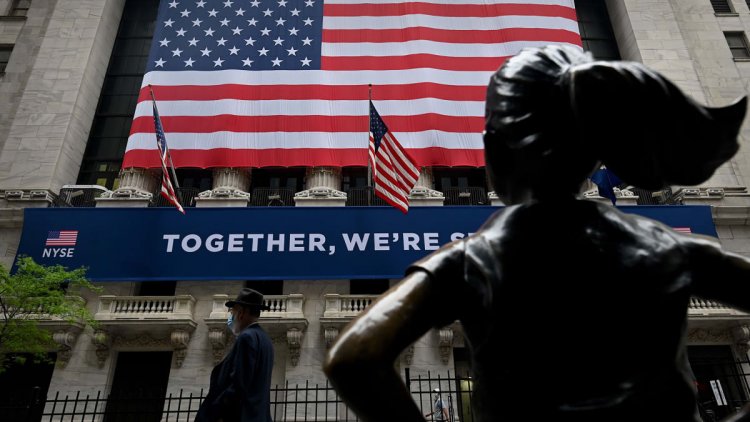Wall Street's Most Important Number Hit 4% Wednesday - And That's Bad News For Stocks
The market's most important data point just hit a level last seen in November. That's bad news for stocks.

The market's most important data point just hit a level last seen in November. That's bad news for stocks.
Updated at 11:55 am EST
U.S. stocks moved lower Wednesday, following on from Wall Street's second monthly decline in the past three, as the market's most important near-term indicator breached levels last seen in late October.
Benchmark 10-year Treasury note yields were marked 4 basis points higher on the session at 3.983%, but hit 4.001% earlier in the session, the highest in four months and a level that has been linked to both the start of the stock market's October rally and its fizzingly out in early February.
The moves were triggered in part by a twin set of faster-than-expected inflation readings in Europe, with France reporting a record high rate 7.2% for the month of February yesterday and Germany following up today with a hotter-than-forecast reading of 9.3%.
Germany government bond yields, a proxy for regional interest rate forecasts, touched the highest levels since 2008 on Wednesday with benchmark 2-year bunds, also known as Schatz, rising to 3.215% and 10-year yields pegged at 2.724%.
The figures followed further indications of elevated price pressures in the U.S. economy, where the so-called 'prices paid' index of the closely-watched ISM manufacturing activity survey jumped six points last month, even as the overall reading indicated a fifth consecutive month of contraction.
Earlier Wednesday, China's National Bureau of Statistics said manufacturing activity in the world's second-largest economy powered to its fastest pace since 2012 last month as Covid restrictions were lifted and the workers and investors returned from the Lunar New Year holidays.
The stronger-than-expected rebound, which was echoed by a private PMI survey published by Caixin Global, lifted global commodity prices and triggered the strongest single-day gains for Asia stocks in at least seven weeks.
The impact of a sustained China recovery, however, remains a topic of hot debate among analysts, some of whom suggest it will stoke global inflation. Others, meanwhile, say the low-priced exports and freed-up supply chains will have the opposite affect.
"While the 'transitory' nature of inflation has manifested in the form of improved supply chain dynamics and easier year-over-year comparisons, the 'stickiness' of prices has been evident in both consumer and wholesale metrics, suggesting the cooling trend is moderating," said John Lynch CIO at Comerica Wealth Management.
Domestically, Goldman Sachs (GS) - Get Free Report CEO David Solomon has also warned that price pressures are likely to remain "sticker" over the coming months, a view echoed by Target (TGT) - Get Free Report CEO Brian Cornell and recently expressed by Bank of Canada Governor Tiff Macklem.
Atlanta Fed President Raphael Bostic said Wednesday that finding a benchmark interest rate that straddles the "delicate balance" of taming inflation while preventing the economy from tipping into recession likely means a terminal rate that rises past 5% and remains there "well into 2024".
"History teaches that if we ease up on inflation before it is thoroughly subdued, it can flare anew ... We must determine when inflation is irrevocably moving lower. We're not there yet."
That likely means more upward pressure on bond yields, as well, as the CME Group's FedWatch now indicates a 35% chance of a 50 basis point rate hike next month in Washington, with the odds of a terminal rate in the region of 5.5% to 5.75% rising to 41.3% in July.
The S&P 500 has given back around 5.5% since the close of trading on February 2, while benchmark 10-year Treasury note yields have surged more than 55 basis points over the same period of time to test the technically significant level of 4% for the first time since early November.
The 4% level for 10-year Treasury yields, in fact, guided stocks into their late-season rally last year, with the S&P 500 only gaining traction to the upside when the paper trended back towards 4% in late October.
The close connection between stock momentum and Treasury bond yields is likely to define the benchmark's performance over the next few months, as well, as investors price in a higher Fed Funds rate off the back of faster inflation readings.
"Considering these challenges and the impact of inflation on market multiples, it is conceivable we retest the October lows in the coming months as markets try to establish a bottom," said Lynch. "As investors price in recovery off the lows, we continue to look for the S&P 500 to be fairly valued in the range of 4,150 by year end."
Stocks on Wall Street were moving lower following the 4% breach on 10-year note yields, with the S&P 500 marked 7 points lower on the session to trim its year-to-date gain to around 3%.
The Dow Jones Industrial Average, meanwhile, was marked 75 points higher on the session while the rate-sensitive Nasdaq gave back earlier gains to trade 35 points in the red.
What's Your Reaction?



























































